This Week’s Guest Blogger is Sue Bradley who writes about gardening for a variety of magazines and loves spending time on her allotment 850ft above sea level in the Cotswolds.

Sue Bradley Photo by Andrew Higgins
It’s my privilege to spend much of my working life admiring and writing about gardens of all shapes, sizes and styles, yet even the kindest people taking a look at my allotment would be pushed to describe it as even remotely ‘tidy’.
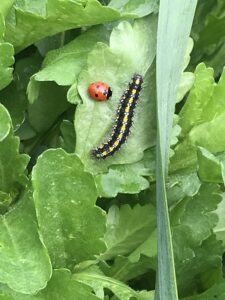
Scarlet Tiger Moth Caterpillar and Ladybird
The contrast between my haphazard and often unruly mix of fruit, vegetables and flowers is accentuated by the neat rows cultivated by the retired carpenter on the neighbouring plot.
That’s not to say that my allotment suffers from a lack of interest from me: I’m up there almost every day, delivering offerings for one of the many compost ‘daleks’ dotted around, topping up the tank of rainwater with the runoff from my greenhouse roof or simply taking a break from my computer.
And while I’m pottering around, pulling up a sprig of goose grass here or an emerging stem of bindweed there, often my attention is drawn to the wildlife that’s set up home on my plot.
There’s the cheeky robin chattering just inches away from my ear, stripy scarlet tiger moth caterpillars inching their way along the leaves of stinging nettles in a moist corner by the tiny pond or, if I’m very quiet, a couple of slow worms absorbing the heat beneath an old rubber dustbin lid on a compost heap.
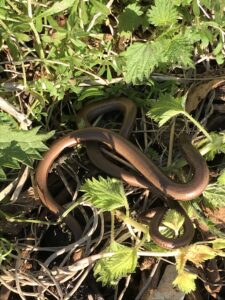 Slow Worm
Slow Worm
This year a tiny wren has built a nest in a narrow crack in the doorframe of my rickety old shed, constructed from pallets by a resourceful gardener many years ago. Even the retired carpenter says it’s ‘magic’ to watch the bird flying in and out when he’s taking a break.
Believe it or not, my allotment was even more untidy when I took it on 20 or so years ago. The soil, a clay-Cotswold brash combo, was horribly compacted; wet and sticky in winter and hard as a rock in summer. The roses I’ve planted over the years love it, but back then it definitely wasn’t what horticulturalists would describe as ‘friable’.
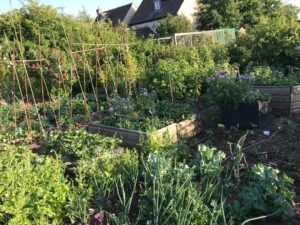
The Allotment
With two young children who didn’t share their mum’s enthusiasm for the ‘lotment’, and an undiagnosed medical condition that often left me doubled up with pain after digging and weeding sessions, getting the soil in any kind of state for growing vegetables was a real challenge.
So, I looked for ways to make life easier. A course organised by the Gloucestershire Wildlife Trust introduced me to the concept of ‘lasagne gardening’, which involved putting sheets of cardboard directly on the soil, piling on vegetable waste from my kitchen and topping it off with grass cuttings. It was also recommended that holes were made in the cardboard and potatoes placed within them, which I also tried.
The thinking is that the cardboard stops weeds from growing and, together with the vegetable waste, slowly rots and is taken into the soil by worms. The grass cuttings provide a ‘thatch’, keeping the surface of the soil that bit warmer to encourage the process.
Harvesting the potatoes breaks up the soil and incorporates the composted materials, leaving it in better shape for future crops.
This method has assisted me in creating several clear patches of soil for sowing seeds over the years and I still use it when clearing weedy areas.
Another breakthrough came when I started growing carrots in containers, or rather, old galvanised dustbins; the holier the better! Previously, any attempt I’d made to grow them in the ground ended in tears due to a combination of slugs eating seedlings and carrot flies burrowing into any roots that had got past the starting point. But raising them in an elevated position where molluscs rarely trod and the dreaded insect didn’t fly meant I could harvest many sweet crunchy carrots. Even my kids were impressed.
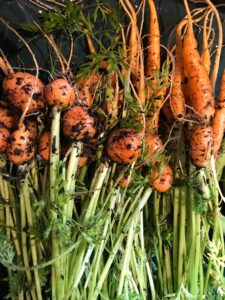 Carrots grown in dustbins
Carrots grown in dustbins
And so my allotment life has continued, with more space becoming available each year and the soil greatly improved by the addition of the contents of my dalek compost heaps. Nine years ago a wonderful surgeon discovered the rare and potentially life-threatening cause of the random stomach pains that had plagued me for so long and, after an emergency operation to remove a section of large bowel that had been prone to twisting, I’ve not looked back.
As for my allotment, it’s tidier than it used to be, but I’ve grown used to, and take great joy from, sharing it with wild creatures: I’m never in a hurry to pull out the speedwell that emerges around my strawberries in spring as I know it encourages aphid-eating ladybirds, and I’ll leave many of the poppies that appear in my vegetable beds as I know they’ll encourage pollinating insects and, let’s face it, they’re so pretty.
My garden has taught me so much over the years: that mountains of compost and leaf mould spread over many autumns and spring makes such a huge difference to the soil I’m working with; that planting roses means I’m never without flowers over the summer months, and that things won’t always go my way, but when the pests strike, I’m surrounded by friends who will help me keep them at bay.
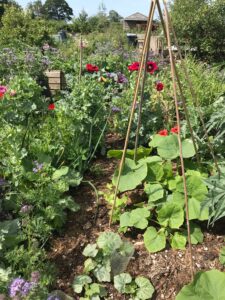
Poppies on the Allotment
